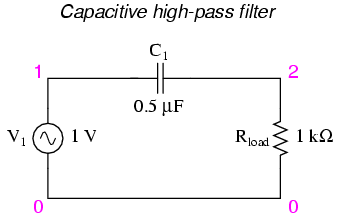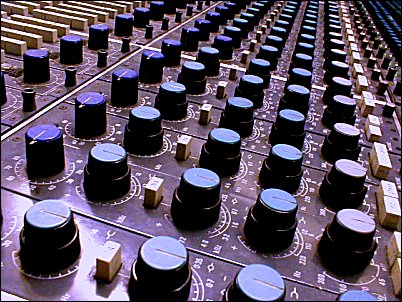Filters
Cutting unwanted frequencies
http://www.opamp-electronics.com/tutorials/high_pass_filters_2_08_03.htm
One of the most important parts of mixing audio is getting rid of unwanted frequencies and trimming down the area in the frequency spectrum that each instrument takes up. To do this we can use a circuit known as a filter. Whether it is high pass, low pass, high shelf, low shelf, band pass, or band cut, a form of this circuit can be used. The circuit shown is a basic capacitive high pass filter. We can change the value of Rload and C to make the cutoff frequency where we want. If the cutoff frequency is given as Fb, then Fb = 1/RC. The cutoff frequency is the point where the transfer function has dropped by 3 db. The voltage transfer function in db is given by 20 * log(Voltage Out / Voltage In). A lowpass filter is almost identical except we would take the voltage drop across the capacitor rather than the resistor. If we wanted to use inductors we could, but for a high pass filter we would take the voltage across the inductor and for a low pass filter we would take the voltage across the resistor.
Studio Equalizers
http://www.protoolerblog.com/2007/06/03/spotlight-eqs-part-ii/
Most people are pretty familiar with equalizers whether they realize it or not. Most stereos and cd players have some sort of adjustable high/mid/bass that people can mess with until they are happy with the sound. In the studio equalizers are a bit more complex. Have you ever wondered what all the knobs on one of those mixing boards actually do? On each channel there is usually a 4 knob equalizer which can be used to adjust certian ranges of frequencies. Mixing engineers use these knobs knowledgably, adjusting frequencies until every track fits well. Equalizers will also introduce phase shifts to the audio. The capacitor from the circuit above adds a complex value to the impedence, which means that the phase of the output will be slightly shifted. This is true for an inductive filter circuit as well. When mixing it is important to keep this in mind becausee the more a certain frequency is boosted the more the phase will shift. Phase shifting will create some strange audio effects, especially if an instrument was recorded with more than one mic. If a significant phase shift is introduced to one of the tracks but not the other, frequencies will start to cancel eachother out. Phase problems in a mix will cause the audio to sound as if it coming from outside the speaker.
Sources
- Electrical Engineering. Principles and Applications
One of my textbooks in my EE class - one of my main references for this page. - Electric Circuits
Amazing EE Textbook that thouroughly explains filters and op-amps - Audio Circuits
This site explains some basic audio amplifier circuits - Free Circuit Diagram
I used this diagram of a basic compressor to illustrate a basic compressor circuit - Alectronics
Website with comprehendable/buildable audio circuits - Electroschematics
This site has tons of electric diagrams that have explanations of how they work
